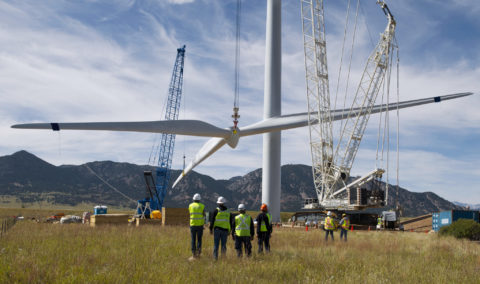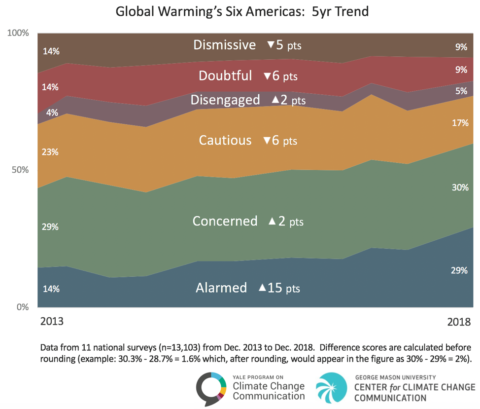
On Earth Day, people around the world take stock of how our countries and communities are doing in addressing the challenges that threaten our environment and health—today and for generations to come.
As the window of opportunity to address climate change narrows, we must do more.
While stark warnings from the scientific community, frequent illustrations of the economic benefits of clean energy, and vivid demonstrations of the human impacts of climate change have helped shift the political calculus in Washington, the best and most immediate opportunity for national policy change in 2019 is in states.
And the progress in states so far this year provides a lot of reasons to be hopeful.
In the 2018 midterms, energy and climate emerged as top-tier issues for voters and are poised to figure prominently again in 2020. Candidates in every region of the country, Democrats and Republicans, made energy and/or climate central to their election messages—and won. Nowhere was this trend more visible than in the states, where at least nine candidates for governor who were elected in 2018 made bold commitments of 100 percent clean electricity. For example, New Mexico Governor Michelle Lujan Grisham (D), who climbed a 26-story wind turbine during her campaign, already has signed a law to put her state on a path to 100 percent clean.
Through the first 100 days of these new governors’ terms, in state after state, the candidates who campaigned on energy and climate are now governing on energy and climate. Most of the national media attention has focused on the Green New Deal and how some congressional Republicans are beginning to bring ideas to the table. But when it comes to actually cutting carbon and growing the economy in 2019, the real deal has been in states.
Take a look at just a few of the achievements in states so far in 2019:
- In Arizona, the Navajo Nation voted down the purchase of the Navajo Generating Station (the largest coal-fired power plant west of the Mississippi), and the Nation’s president and vice president signed a proclamation supporting the tribe’s transition to renewable energy.
- In Arkansas, the Republican-controlled General Assembly passed, and Governor Asa Hutchinson (R) signed, the Solar Access Act of 2019, removing regulatory barriers that have slowed Arkansas’s solar market for years.
- Colorado Governor Jared Polis (D) signed an executive order that includes the adoption of the zero-emissions vehicle law that California and several other states have adopted. On climate, House Speaker KC Becker (D) introduced a bill requiring cuts in carbon pollution by at least 25 percent by 2026, 50 percent by 2030, and 90 percent by 2050 compared to 2005 levels.
- Maryland’s legislature passed the Clean Energy Jobs Act, which would increase the state Renewable Portfolio Standard to 50 percent by 2030 and provide funding for workforce development programs. The bill is on Governor Larry Hogan’s (R) desk.
- New Mexico Governor Lujan Grisham signed the Energy Transition Act requiring 100 percent carbon free energy from the state’s utilities by 2045. New Mexico also passed a law expanding electric vehicle charging infrastructure, with a focus on equity.
- In Oregon, a House committee began consideration of a cap-and-invest bill, a top priority for Governor Kate Brown (D).
- Washington’s state legislature passed a 100 percent clean law through both houses and is currently reconciling minor differences between the versions. Puerto Rico and Washington, DC enacted 100 percent laws. Minnesota, Illinois, Wisconsin, New York, Nevada, Maine, and Florida introduced bills for 100 percent clean or carbon-free electricity this year.
 Americans’ concern about climate change is high and rising. Sixty percent of Americans are either “alarmed” or “concerned” about climate change, according to the latest survey by the climate change communications programs at Yale and George Mason universities. That’s a sharp increase since five years ago when only 43 percent felt the same way. This dramatic shift in public opinion is one of the factors driving the pace of change in the states—and the willingness of elected leaders to reach for more ambitious goals.
Americans’ concern about climate change is high and rising. Sixty percent of Americans are either “alarmed” or “concerned” about climate change, according to the latest survey by the climate change communications programs at Yale and George Mason universities. That’s a sharp increase since five years ago when only 43 percent felt the same way. This dramatic shift in public opinion is one of the factors driving the pace of change in the states—and the willingness of elected leaders to reach for more ambitious goals.
To be sure, there is still a lot to do—in states, nationally, and globally. But the momentum of policy and political progress is rapidly building, giving us plenty of reason to be hopeful this Earth Day.
Note: Energy Foundation does not fund lobbying activities. References to legislation are for informational purposes only.
